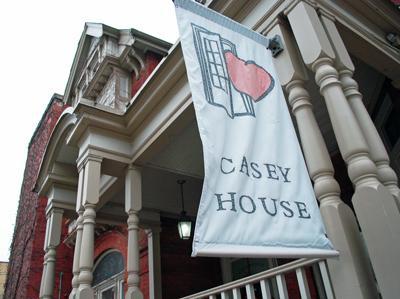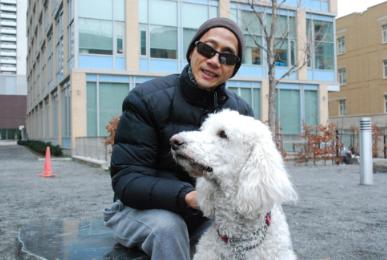
Casey House in Toronto. Credit: Rob Salerno
Seven years ago, HIV survivor Kenneth Poon was so sick his body had deteriorated to a frail 65 pounds. He lost his sight and couldn’t walk. At Casey House, the Toronto hospice he called home for more than two years, he was moved to the “big room upstairs” — the room patients never leave.
Miraculously, doctors brought him back from the brink. In 2007, he was given the good news that he was being discharged.
However, unable to live independently, Poon was forced to quit his job as a fashion designer for Holt Renfrew, sell his house and move into a nursing home temporarily. He was 45 years old at the time.
At Lincoln Place, where Poon was the only openly gay resident, he kept to himself. The average age of other residents was about 80; many had dementia and Alzheimer’s. He felt isolated and alone.
One day at dinner he noticed there was blood dripping down his arm from a small cut. A personal support worker (PSW) grabbed him, held up his arm and pulled him into the nurse’s station. “He has HIV,” shouted the PSW. “Kenneth is bleeding. He has AIDS!”
Poon says everything stopped.
“There is normally a hum of chatter and footsteps in the hall, but at that moment you could hear a pin drop. The PSW did the worst thing. He disclosed my status. By the end of the night, everyone knew I was positive.”
After that, things changed. Residents stopped talking to him and many kept their distance. At mealtime, people asked staff to pass the bread to avoid talking to Poon directly.
Poon contacted Casey House, whose staff visited Lincoln Place and offered information and education to staff there. Poon says that the stigma people with HIV continue to face in long-term care, along with homophobia and transphobia, forces queer seniors back into the closet.
“Long-term care facilities are not ready. All staff need training and residents need education because there is so much stigma and discrimination in long-term care,” he says. “With the drugs today, people with HIV can live to age 80, but eventually everyone needs someone to look after them.”
Poon now lives in a Toronto apartment with his guide dog, Aiyden, and his partner, Al.
But he is not alone. Experts in long-term care and HIV/AIDS are noticing an alarming gap. People with HIV are living decades longer than before and are dealing with a host of illnesses associated with aging, such as dementia, cancer, diabetes, liver disease, osteoporosis and kidney problems.
That’s why Sue Graham-Nutter, executive director of corporate affairs and communications for the Rekai Centre at Wellesley Central Place, reached out to Casey House for help.
There is growing recognition in long-term care that more training is needed for providers so they are prepared for more people living with HIV entering the system, she says.
“What we are finding is people with HIV/AIDS are aging at a much faster rate than the norm,” she says. “At much earlier ages, some as young as 40 or 50, it seems their bodies are exhibiting characteristics [associated with] aging faster than the regular population.”
Medical treatments and antiretroviral drugs have advanced considerably over the past 20 years. HIV is no longer a death sentence, doctors at Casey House say; it’s now a chronic disease.
There are more than 7,254 people living with HIV/AIDS in Ontario over the age of 50 years, according to the province’s vital statistics registrar. Of that number, 62 percent live in Toronto.
“I was staggered when I looked at those numbers. It’s much higher than I thought it would be,” Graham-Nutter admits. “These are people in their 50s, 60s and 70s that doctors didn’t think would live. Now that’s an issue for long-term care. Their needs are much different.”
Stephanie Karapita, chief executive officer at Casey House, says there is a lack of awareness about the “greying of AIDS” in long-term care, particularly in facilities outside downtown Toronto.
“We want this to be addressed quickly,” she says. “LGBT seniors are twice as likely to be isolated and live alone. They are quite vulnerable. Add in issues surrounding HIV/AIDS and aging. . .
“The number of people with HIV in Toronto continues to grow. And they are aging.”
Every day, two people in the city are newly infected with HIV/AIDS, and one in 120 adult Torontonians, about 18,000 people, is living with HIV, according to a December report released by Casey House to coincide with World AIDS Day.
The report also found that the number of Ontarians with HIV/AIDS increased by 31 percent between 2003 and 2008 and continues to rise.
“By 2015, more than half of all people with HIV in North America will be over the age of 50,” Karapita says.
“When Casey House first opened in 1988, we were about dying. With the introduction of antiretrovirals in 1996, we shifted our focus to living with HIV. Now we are looking to support people as they age with HIV,” she says.
Graham-Nutter says that if funding is secured, training will be offered to all frontline staff, such as PSWs, nurses, doctors, pharmacists and dieticians.
“Located so close to Toronto’s gay village, [Wellesley Central Place] staff have already had some training, but they need more training. We realize that,” she says.

 Why you can trust Xtra
Why you can trust Xtra


